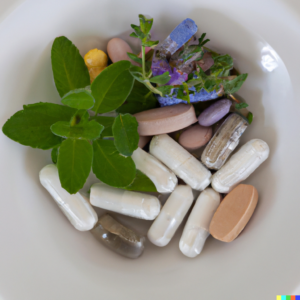
Photo of pills and herbs created by Dall-E-2 as described by Kathy McCabe
For over a decade I have been a chronic pain patient due to a nerve bundle accidentally being sewn into the abdominal wall during a previous surgery. At first, I was prescribed opiates and nerve pain drugs that did not work well. The opiate I was prescribed is the lowest dose available and it alone was adequate, but I could tell I was developing a tolerance for it. When the opioid crisis hit, I was tossed off the drug I was on and told that I needed to return to a drug regimen of nerve pain and antidepressant drugs that had already kept me in bed for weeks due to the horrible side effects and vertigo they caused. When I refused, the pain clinic tossed me out the door – basically refusing to treat me. For over five years I was denied effective pain relief. Thank God I was also researching natural pain relief for my condition.
Over the years I developed a pain blend that worked to take the edge off the pain and give me some semblance of life. I started with a nighttime pain blend – because not sleeping was making my pain even worse. I made use of valerian for its sleep-enhancing properties, chamomile for its anti-inflammatory and relaxing properties, and lemon balm – which was a surprisingly effective addition because I normally feel energized when I inhale its scent but it’s also highly anti-inflammatory and very relaxing.
I began with infusions but wanted to develop a tincture that would make it more convenient to take. As I acquired more research and knowledge I began adding in other herbs: Wild lettuce, also known as Lactuca virosa, has been used traditionally for its mild sedative and analgesic properties. The milky latex from the plant’s leaves contains compounds believed to have pain-relieving effects. Advocates of wild lettuce often use it to address conditions such as migraines, arthritis, and muscle pain. (Khan I, Abourashed EA. Le lettuce alkaloids: “lettuce opium” revisited. J Nat Prod. 2010;73(6):1204-1207.); California poppy has been traditionally used by Native Americans for its mild sedative and pain-relieving effects. The plant contains alkaloids that may contribute to its analgesic properties, making it a potential natural remedy for nerve pain and discomfort. (References: Gafner S, Bergeron C, Batcha LL, Reich J, Sudberg S. Alkaloids of Eschscholzia californica and their biological activity. J Nat Prod. 1996;59(7):590-596.); Meadowsweet is renowned for its anti-inflammatory and analgesic properties, attributed to salicylates found in the plant. This makes it a natural alternative for individuals seeking relief from conditions like arthritis and joint pain. (References: Schmid B, Lüdtke R, Selbmann HK, et al. Efficacy and tolerability of a standardized willow bark extract in patients with osteoarthritis: a randomized placebo-controlled, double-blind clinical trial. Phytother Res. 2001;15(4):344-350.).
It was important to also vary the herbs to alleviate any tolerances developing, but I also made seasonal adjustments based on the time of year, in the winter when the days are shorter, and darker, and in south-central Pennsylvania, frequently overcast, I added in St. John’s Wort for mild depression, but its also quite effective for pain relief (just watch your exposure since sunlight might affect its efficacy) (References: Linde K, Berner MM, Kriston L. St John’s wort for major depression. Cochrane Database Syst Rev. 2008;4(4): CD000448.)
Nature has bestowed upon us a diverse array of botanical remedies that offer gentle yet effective pain relief. Wild lettuce, chamomile, California poppy, meadowsweet, valerian, and St. John’s Wort represent just a fraction of the plant kingdom’s potential to promote well-being. As with any natural remedy, it is crucial to consult with healthcare professionals before incorporating these herbs into your wellness routine. The synergy between these herbs and the adjustment to seasonal needs provides a holistic approach to managing pain, catering to the body’s natural rhythms.
Finally, I am nearly pain free. I had a spinal cord stimulator implant in November, and even though I’m not fully healed from the surgery, the pain in the abdominal wall is down by over 80%. Directly after surgery I utilized low-dose opioids for acute pain relief – but found that after so long without them, I couldn’t tolerate more than half the dosage. Very shortly after coming home, I transitioned back to my herbal pain remedies for relief.
Although it’s only been a month and 3 days since the surgery, I believe the implant has been a success, and adjustments can still be made to fine-tune the stimulation.
I anticipate being able to live a completely different life now – a much more active life. However, I will continue to utilize plants as my main source of pain relief. I’m looking forward to more plant walks, photo excursions, motorcycle riding with my husband, and maybe even dancing.
God is good.

Kathy is an herbalist/naturopathic practitioner who is constantly researching to expand her knowledge. She came to herbalism after her migraine medicine was suddenly removed from the market and she had to find something new. After discovering the magic of herbs she’s never looked back. She is accredited by the International Practitioners of Holistic Medicine (IPHM) and is an Associate Member of the American Herbalist Guild.